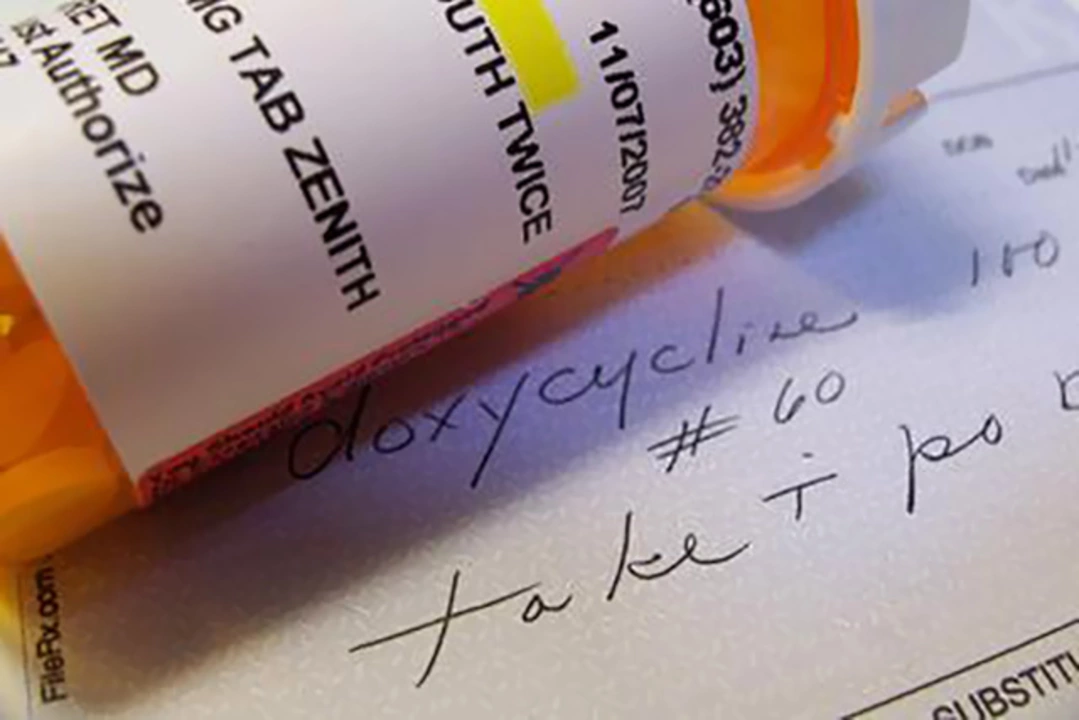Doxycycline in Dermatology: A Comprehensive Review
Introduction to Doxycycline and its Role in Dermatology
As a blogger with keen interest in dermatology, I have come across various treatments and medications for skin conditions. One such medication that has piqued my interest is doxycycline. In this article, I will be providing a comprehensive review of doxycycline, its uses in dermatology, potential side effects, and more. So, let's dive right in and explore the role of doxycycline in dermatology.
Understanding Doxycycline: What is it and How Does it Work?
Doxycycline is a type of antibiotic that belongs to the tetracycline class. These antibiotics work by inhibiting bacterial protein synthesis, ultimately preventing the growth and spread of bacteria in the body. Doxycycline is a broad-spectrum antibiotic, meaning it is effective against a wide range of bacterial infections. In dermatology, doxycycline is commonly prescribed to treat acne, rosacea, and skin infections.
Doxycycline in the Treatment of Acne
Acne is a common skin condition that affects millions of people worldwide. It occurs when hair follicles become clogged with oil and dead skin cells, leading to inflammation and the formation of pimples, blackheads, and whiteheads. Doxycycline is often prescribed for moderate to severe acne, as it helps to reduce the inflammation and bacterial infection associated with acne breakouts.
When used for acne treatment, doxycycline is typically taken orally in the form of a pill or capsule. The dosage and duration of treatment will vary depending on the severity of the acne and the individual's response to the medication. It is important to note that doxycycline may not show immediate results and can take several weeks to months for visible improvement in the skin.
Managing Rosacea with Doxycycline
Rosacea is a chronic skin condition characterized by facial redness, visible blood vessels, and sometimes acne-like breakouts. The exact cause of rosacea is unknown, but it is believed that an overgrowth of certain types of bacteria on the skin may contribute to the condition. Doxycycline is often prescribed to help manage rosacea symptoms by reducing inflammation and targeting the bacteria responsible for the condition.
For rosacea treatment, doxycycline is usually taken orally at a lower dosage than that used for acne. This lower dosage helps to minimize potential side effects while still providing the anti-inflammatory and antibacterial benefits needed to manage rosacea symptoms.
Treating Skin Infections with Doxycycline
Aside from acne and rosacea, doxycycline is also used to treat various skin infections caused by bacteria. These can include cellulitis, impetigo, and folliculitis, among others. The antibiotic properties of doxycycline work to kill the bacteria responsible for the infection, allowing the skin to heal and recover.
When prescribed for skin infections, the dosage and duration of doxycycline treatment will depend on the type and severity of the infection. It is crucial to follow the doctor's instructions and complete the full course of antibiotics to ensure the infection is effectively treated and to prevent the development of antibiotic-resistant bacteria.
Potential Side Effects of Doxycycline
While doxycycline can be an effective treatment for various skin conditions, it is not without potential side effects. Some common side effects may include gastrointestinal issues such as nausea, vomiting, diarrhea, and loss of appetite. Additionally, doxycycline can cause photosensitivity, making the skin more sensitive to sunlight and increasing the risk of sunburn.
It is essential to discuss any potential side effects with your doctor before starting doxycycline treatment and to report any severe or persistent side effects during treatment. In some cases, your doctor may need to adjust the dosage or switch to an alternative antibiotic if side effects become too bothersome.
Precautions and Contraindications
There are certain situations in which doxycycline may not be appropriate, or precautions may need to be taken. Pregnant or breastfeeding women should avoid doxycycline, as it can potentially harm the developing fetus or be passed through breast milk. Additionally, doxycycline should not be used in children under the age of 8, as it can cause permanent tooth discoloration in developing teeth.
Individuals with a history of kidney or liver issues, or those who are allergic to tetracycline antibiotics, should inform their doctor before starting doxycycline treatment. In some cases, an alternative antibiotic may be recommended.
Interactions with Other Medications
Doxycycline can interact with certain medications, potentially reducing their effectiveness or increasing the risk of side effects. Some common medications that may interact with doxycycline include antacids, iron supplements, and certain acne medications such as isotretinoin. It is crucial to inform your doctor of any medications or supplements you are currently taking before starting doxycycline treatment.
Conclusion
In conclusion, doxycycline can be an effective treatment option for various skin conditions, including acne, rosacea, and bacterial skin infections. While it does come with potential side effects, it remains a valuable tool in the dermatological field. As with any medication, it is essential to discuss your individual needs and concerns with a healthcare professional to determine if doxycycline is the right choice for you.







17 Comments
Earl Hutchins
May 9, 2023 at 22:26
Doxycycline works by stopping bacterial protein synthesis which cuts down inflammation in acne and rosacea. It’s important to take it with a full glass of water and stay upright for at least thirty minutes to avoid esophageal irritation. Sun protection is a must because the drug can cause photosensitivity. If you notice persistent nausea or diarrhoea talk to your physician about adjusting the dose. For pregnant women and kids under eight the medication is generally avoided due to tooth discoloration risks.
Tony Bayard
May 15, 2023 at 04:26
Reading through the review felt like opening a treasure chest of dermatological insights; the way doxycycline tackles both bacteria and inflammation is simply fascinating. I can’t help but imagine the relief patients feel when stubborn acne finally clears after weeks of diligent therapy. The balance between effectiveness and side‑effects is a delicate dance, and your thorough breakdown shines a spotlight on that choreography. It’s reassuring to see the emphasis on sun protection – a reminder that even antibiotics have a solar side. Overall, the article blends solid science with a compassionate tone that any dermatologist would applaud.
Jay Crowley
May 20, 2023 at 10:26
Doxycycline is effective but watch for sun sensitivity.
sharon rider
May 25, 2023 at 16:26
In the broader tapestry of skin health the choice of doxycycline reflects a measured approach that honors both microbial control and the body’s own healing rhythms. While the drug offers clear benefits for acne and rosacea, it also invites us to consider the subtle interplay between medication and lifestyle, especially regarding sun exposure and dietary supplements. The article reminds us that every prescription is a dialogue between clinician and patient, a quiet negotiation that shapes outcomes over time.
swapnil gedam
May 30, 2023 at 22:26
Doxycycline’s broad‑spectrum activity makes it a go‑to option for many dermatologists dealing with acne, rosacea, or bacterial infections. The review nicely outlines the standard dosing ranges – typically 100 mg daily for acne and a lower sub‑antimicrobial dose for rosacea – and highlights the importance of adherence for several weeks to see results. Side‑effects such as gastrointestinal upset and photosensitivity are well documented, and the piece wisely advises patients to use sunscreen and avoid prolonged sun exposure. It also notes contraindications like pregnancy and pediatric use, which are crucial for safe prescribing. Overall, the overview offers a balanced perspective without overstating the drug’s capabilities.
Michael Vincenzi
June 5, 2023 at 04:26
Great summary! I’ve seen doxycycline work wonders for stubborn breakouts on my own skin, especially when paired with a good cleanser and sunscreen. Just remember to stay hydrated and keep the meds taken with food if your stomach gets upset. Thanks for putting together a clear guide.
Courage Nguluvhe
June 10, 2023 at 10:26
The pharmacodynamics of doxycycline involve inhibition of the 30S ribosomal subunit, effectively halting bacterial translation processes. Clinically this translates to a reduction in Propionibacterium acnes colonisation and subsequent inflammatory cascade attenuation. For rosacea, the sub‑antimicrobial dosing exploits the drug’s anti‑inflammatory properties without exerting significant bacteriostatic pressure, thereby minimising resistance development. Adherence to a strict photoprotection regimen is non‑negotiable given the drug’s photosensitising potential. Monitoring hepatic and renal function is advisable in long‑term courses to preempt toxicity.
Oliver Bishop
June 15, 2023 at 16:26
As an American I’m proud that doxycycline is readily available here and has helped countless folks clear up their skin without breaking the bank. The review does a solid job showing why it stays a staple in our dermatology toolbox.
Alissa DeRouchie
June 20, 2023 at 22:26
Honestly the whole hype around doxycycline seems overblown there are plenty of other options that work just as well if not better yet people keep pushing this antibiotic as the miracle cure for every skin woe it's convenient to advertise but the side effects like photosensitivity and gut upset are often downplayed we need to look at the bigger picture and consider lifestyle changes alongside any medication the article glosses over those nuances leaving readers with a one‑sided view and that just isn’t helpful
Emma Howard
June 26, 2023 at 04:26
Wow Alissa you raise some valid points!!! While doxycycline is indeed popular it’s not a magic bullet and we all need to be aware of the potential downsides. 👍 It’s great to see a balanced discussion that includes both pros and cons!!!
dee gillette
July 1, 2023 at 10:26
While the review presents doxycycline in a generally positive light, it neglects to sufficiently address the growing concerns regarding antimicrobial resistance. A more critical appraisal would consider alternative therapies and the long‑term implications of widespread antibiotic use in dermatology.
Jasin P.
July 6, 2023 at 16:26
Oh absolutely, because the world’s biggest skin problem is definitely antibiotic resistance… not like people want clear skin tomorrow, right?
Lily Đàn bà
July 11, 2023 at 22:26
Reading this feels like watching a fireworks display that never ends-bright, loud, but after a while you just want the quiet. Doxycycline might be a hero in the short term, but the lingering shadows of side effects and resistance linger like a storm on the horizon. We should temper our applause with caution.
Joseph O'Sullivan
July 17, 2023 at 04:26
Mate, it’s like choosing a sword in a fight-you need the right tool for the right battle. Doxycycline’s sharp edge cuts inflammation but you don’t want it to slice too deep into your gut or your future. Balance, that’s the key.
Conor McCandless
July 22, 2023 at 10:26
Doxycycline, a stalwart of the tetracycline family, has long held a venerable position in the dermatologist’s armamentarium, offering a blend of antibacterial and anti‑inflammatory properties that make it uniquely suited for tackling the multifaceted challenges of acne and rosacea. Its mechanism of action, rooted in the inhibition of the 30S ribosomal subunit of susceptible bacteria, not only curtails microbial proliferation but also dampens the cascade of inflammatory mediators that perpetuate lesion formation. When prescribed at a conventional dose of one hundred milligrams daily, the drug exerts a robust bacteriostatic effect that can dramatically reduce the colony count of Propionibacterium acnes on the skin’s follicular niches. Conversely, the sub‑antimicrobial dosing regimen, often six hundred milligrams once weekly or a low dose of fifty milligrams daily, leverages doxycycline’s capacity to modulate matrix metalloproteinases and cytokine production without imposing significant selective pressure on bacterial populations. This nuanced approach allows clinicians to tailor therapy to the specific pathophysiology of the patient’s condition, whether the dominant factor is bacterial overgrowth or a dysregulated inflammatory response. Yet, the clinical benefits promised by doxycycline are not without attendant considerations, for the drug’s propensity to induce photosensitivity necessitates diligent sun protection measures, a fact that cannot be over‑stated in sunlight‑rich environments. Moreover, gastrointestinal disturbances, ranging from mild nausea to more severe diarrhoea, may compromise patient adherence, thereby undermining therapeutic outcomes. The specter of tooth discoloration looms for pediatric patients under eight years of age, rendering the antibiotic contraindicated in that demographic and underscoring the importance of age‑appropriate prescribing. Renal and hepatic function must also be evaluated, particularly in patients embarking on prolonged courses, to preempt accumulation and potential toxicity. The interplay between doxycycline and concomitant medications, such as antacids containing magnesium or calcium, iron supplements, and certain retinoids, further complicates the therapeutic landscape, as these agents can chelate the drug and diminish its absorption. In light of rising concerns about antimicrobial resistance, the sub‑antimicrobial dosing strategy emerges as a prudent compromise, preserving efficacy while mitigating the risk of fostering resistant strains. Nonetheless, clinicians must remain vigilant, balancing the immediate desire for cutaneous improvement against the long‑term public health implications of widespread antibiotic use. Patient education, therefore, becomes an indispensable component of any doxycycline regimen, ensuring that individuals understand the necessity of adherence, sun avoidance, and prompt reporting of adverse effects. Regular follow‑up appointments allow the clinician to assess response and adjust dosage as needed. In sum, doxycycline embodies a powerful, yet double‑edged, instrument in dermatologic therapy, demanding judicious use, comprehensive monitoring, and an appreciation of its broader impact on both individual patients and the microbial ecosystem.
kat gee
July 27, 2023 at 16:26
Wow, thanks for the novel-now I know more about doxycycline than I ever wanted.
Iain Clarke
August 1, 2023 at 22:26
The review does a solid job summarizing doxycycline’s indications, dosing nuances, and safety considerations. For anyone starting therapy, remember to take the medication with plenty of water, avoid lying down shortly after, and use broad‑spectrum sunscreen daily. Discuss any history of liver or kidney disease with your doctor before beginning treatment. If side effects become bothersome, a dose adjustment or alternative agent may be appropriate. Overall, doxycycline remains a valuable tool when used responsibly.